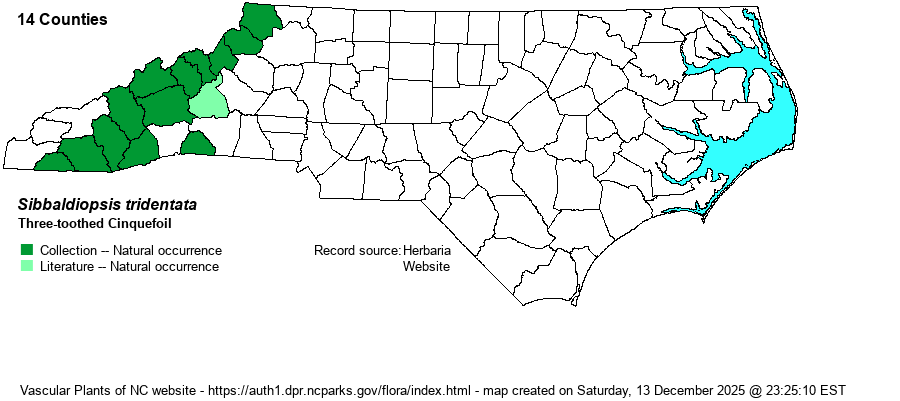| Author | (Aiton) Rydberg | |
| Distribution | Essentially throughout the Mountains, but perhaps absent from a few far southwestern counties.
This is a Northern species, ranging across most of Canada, and south to New England and IA, southward almost exclusively in the Appalachians to northern GA.
| |
| Abundance | Uncommon and local, limited mostly to exposed rocks at mid- to high elevations. It can be locally common in a few places. This was formerly a Watch List species, but enough reports have accumulated such that it is no longer on that list. | |
| Habitat | This is a rock outcrop species, favoring rocky summits, rock crevices, openings in grassy balds, cliffs and bluffs, and other exposed and generally rocky places -- mainly above 4000 feet elevation. |
| Phenology | Blooms from June to August, and fruits from July to September. | |
| Identification | This species was long included in the genus Potentilla, and like those native species, is a low-growing plant. It has a slightly woody (suffruticose) stem, as short as it is, and the plant is barely 4-6 inches tall or long. It has a cluster of basal leaves, each thick, shiny, dark green in summer, and evergreen, often turning coppery-red color in winter. Each leaf is 3-parted, and each leaflet is only about 1 inch long and 1/2-inch wide, narrowly fan-shaped, with teeth along the apex margin. The separate flowering stalk is only a few inches tall, topped by a few white flowers, each with 5 rounded petals and a spread of only about 1/2-inch across. Though each flower is rather small, considering that this is almost a "mat plant", against bare rocks the flower also seems large for size of the plant. This species is hard to miss at any season, with its 3 shiny leaflets, turning almost red in winter, and toothed at the tips. | |
| Taxonomic Comments | The species was long included in Potentilla in the 20th Century, as P. tridentata. It was moved to Sibbaldiopsis tridentata, and now to Sibbaldia retusa by most recent authorities. However, its final resting place is still not settled; see Weakley (2020), who moved it back to S. tridentata.
| |
| Other Common Name(s) | Mountain Cinquefoil, Mountain White Potentilla, Wineleaf Cinquefoil, Shrubby Five-fingers | |
| State Rank | S3 | |
| Global Rank | G5 | |
| State Status | | |
| US Status | | |
| USACE-agcp | | |
| USACE-emp | | |

